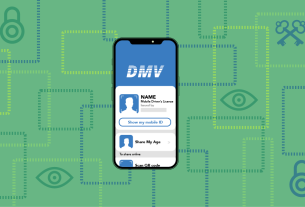With the holidays upon us, it’s easy to default to giving the tech gifts that retailers tend to push on us this time of year: smart speakers, video doorbells, bluetooth trackers, fitness trackers, and other connected gadgets are all very popular gifts. But before you give one, think twice about what you’re opting that person into.
A number of these gifts raise red flags for us as privacy-conscious digital advocates. Ring cameras are one of the most obvious examples, but countless others over the years have made the security or privacy naughty list (and many of these same electronics directly clash with your right to repair).
One big problem with giving these sorts of gifts is that you’re opting another person into a company’s intrusive surveillance practice, likely without their full knowledge of what they’re really signing up for.
For example, a smart speaker might seem like a fun stocking stuffer. But unless the giftee is tapped deeply into tech news, they likely don’t know there’s a chance for human review of any recordings. They also may not be aware that some of these speakers collect an enormous amount of data about how you use it, typically for advertising–though any connected device might have surprising uses to law enforcement, too.
There’s also the problem of tech companies getting acquired like we’ve seen recently with Tile, iRobot, or Fitbit. The new business can suddenly change the dynamic of the privacy and security agreements that the user made with the old business when they started using one of those products.
And let’s not forget about kids. Long subjected to surveillance from elves and their managers, electronics gifts for kids can come with all sorts of surprise issues, like the kid-focused tablet we found this year that was packed with malware and riskware. Kids’ smartwatches and a number of connected toys are also potential privacy hazards that may not be worth the risks if not set up carefully.
Of course, you don’t have to avoid all technology purchases. There are plenty of products out there that aren’t creepy, and a few that just need extra attention during set up to ensure they’re as privacy-protecting as possible.
What To Do Instead
While we don’t endorse products, you don’t have to start your search in a vacuum. One helpful place to start is Mozilla’s Privacy Not Included gift guide, which provides a breakdown of the privacy practices and history of products in a number of popular gift categories. This way, instead of just buying any old smart-device at random because it’s on sale, you at least have the context of what sort of data it might collect, how the company has behaved in the past, and what sorts of potential dangers to consider. U.S. PIRG also has guidance for shopping for kids, including details about what to look for in popular categories like smart toys and watches.
Finally, when shopping it’s worth keeping in mind two last details. First, some “smart” devices can be used without their corresponding apps, which should be viewed as a benefit, because we’ve seen before that app-only gadgets can be bricked by a shift in company policies. Also, remember that not everything needs to be “smart” in the first place; often these features add little to the usability of the product.
Your job as a privacy-conscious gift-giver doesn’t end at the checkout screen.
If you’re more tech savvy than the person receiving the item, or you’re helping set up a gadget for a child, there’s no better gift than helping set it up as privately as possible. Take a few minutes after they’ve unboxed the item and walk through the set up process with them. Some options to look for:
- Enable two-factor authentication when available to help secure their new account.
- If there are any social sharing settings—particularly popular with fitness trackers and game consoles—disable any unintended sharing that might end up on a public profile.
- Look for any options to enable automatic updates. This is usually enabled by default these days, but it’s always good to double-check.
- If there’s an app associated with the new device (and there often is), help them choose which permissions to allow, and which to deny. Keep an eye out for location data, in particular, especially if there’s no logical reason for the app to need it.
- While you’re at it, help them with other settings on their phone, and make sure to disable the phone’s advertising ID.
- Speaking of advertising IDs, some devices have their own advertising settings, usually located somewhere like, Settings > Privacy > Ad Preferences. If there’s an option to disable any ad tracking, take advantage of it. While you’re in the settings, you may find other device-specific privacy or data usage settings. Take that opportunity to opt out of any tracking and collection when you can. This will be very device-dependent, but it’s especially worth doing on anything you know tracks loads of data, like smart TVs.
- If you’re helping set up a video or audio device, like a smart speaker or robot vacuum, poke around in the options to see if you can disable any sort of “human review” of recordings.
If during the setup process, you notice some gaps in their security hygiene, it might also be a great opportunity to help them set up other security measures, like setting up a password manager.
Giving the gift of electronics shouldn’t come with so much homework, but until we have a comprehensive data privacy law, we’ll likely have to contend with these sorts of set-up hoops. Until that day comes, we can all take the time to help those who need it.



